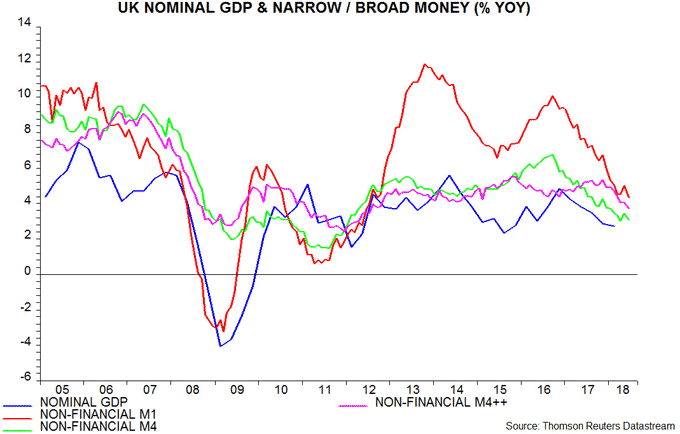UK Inflation Report: monetary muddle
Hallelujah! The August Inflation Report included a box discussing recent monetary developments. The analysis, however, is flawed.
The box appears to have been included to counter the criticism made here and by others that a rate rise was inappropriate because monetary trends have weakened. As the Report notes, “(t)welve-month growth in broad money slowed to 3½% in 2018 Q2, having been above 7% in 2016 H2”.
So why is this of no concern? The Report concedes that “money growth may provide a signal for recent and future trends in activity and inflation”. However, “developments can … also reflect other factors that have limited implications for spending prospects, which appears to have been the case at present”.
The key “other factor” operating at present, it is claimed, is a reduction in households’ precautionary demand to hold money. The Report argues that broad money growth was boosted in 2016 by households switching out of investment funds into liquid assets, with this switch attributed to “heightened uncertainty around the referendum”. The slowdown in household and overall broad money growth more recently “appears in part to reflect some of that precautionary demand subsiding, as investment fund holdings have risen”.
There are several problems with this argument. It is not at all clear why households should be less uncertain about Brexit now than in 2016. The Report does not offer any corroborating evidence of a fall in the precautionary demand for money, apart from the rise in investment fund holdings.
A reduction in household uncertainty, moreover, would be expected to be associated with a positive reassessment of income prospects and spending plans, leading to a rise in the transactions demand for money. This could, in theory, offset or outweigh the fall in precautionary money demand.
Empirically, the argument in the Report implies that an expanded monetary / savings aggregate incorporating investment funds would have displayed stable growth in recent years, with no slowdown recently. This, surprisingly, was not explored, but is not the case.
The chart compares annual growth rates of narrow (M1) and broad (M4) non-financial* money measures and an expanded aggregate including National Savings products, foreign currency deposits and retail flows into UK-registered unit trusts and OEICs (“non-financial M4++”). Growth of the expanded aggregate fluctuated in a relatively narrow range over 2015-17 but has fallen significantly this year, reaching a six-year low of 3.7% in June.

Inflows to retail investment funds have slowed sharply in recent months – they totalled £4.7 billion in the second quarter compared with £12.1 billion a year earlier (IMA data). On the argument of the Report, this reduction should be boosting household money growth.
The view here remains that money trends are weak because spending plans are subdued, depressing the transactions demand for money. Yesterday’s rate increase, while expected, risks exacerbating this weakness.
*Covering holdings of households and private non-financial corporations but excluding those of financial corporations.

Reader Comments